Desmond Bagley was an English journalist and novelist known mainly for a series of bestselling thrillers. He and fellow British writers such as Hammond Innes and Alistair MacLean set conventions for the genre: a tough, resourceful, but essentially ordinary hero pitted against villains determined to sow destruction and chaos for their own ends.

Tortilla Flat (1935) is an early John Steinbeck novel set in Monterey, California. The novel was the author's first clear critical and commercial success.
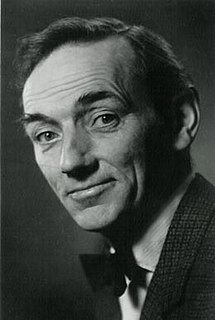
Samuel John Kydd was an Irish actor. His best-known roles were in two major British television series of the 1960s, as the smuggler Orlando O'Connor in Crane and its sequel Orlando. He also played a recurring character in Coronation Street. Kydd's first film was The Captive Heart (1946), in which he played a POW. He made over 290 films, more than any other British actor, including 119 between 1946 and 1952.

"The Devil and Tom Walker" is a short story by Washington Irving that first appeared in his 1824 collection Tales of a Traveller, in "The Money-Diggers" part of volume II. The story is very similar to the German legend of Faust.

Sahara is a 1992 adventure novel by Clive Cussler. It is the eleventh book in Cussler's Dirk Pitt series. The 2005 film Sahara was based on the novel.

"M+M's" is a song by American rock band Blink-182, released as a single from the group's debut studio album, Cheshire Cat (1995), on September 6, 1995. Written by guitarist Tom DeLonge and bassist Mark Hoppus, the song became the band's debut single and their first to receive radio airplay. "M+M's" is sung by Hoppus and the lyrics have a reference to masturbation.
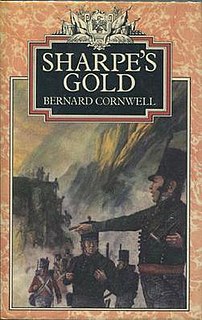
Sharpe's Gold is the second historical novel in the Richard Sharpe series by Bernard Cornwell first published in 1981. The story is set in August 1810 and features the destruction of Almeida during the Peninsular War.
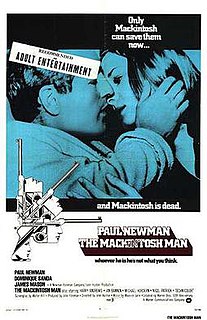
The Mackintosh Man is a 1973 British-American Cold War neo noir spy thriller film, directed by John Huston and starring Paul Newman, Dominique Sanda and James Mason.

Olsenbanden tar gull is a 1972 Norwegian comedy-crime film of the Olsenbanden film series, directed by Knut Bohwim.
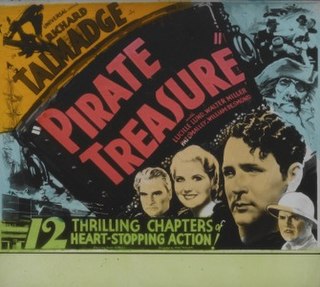
Pirate Treasure is a 1934 Universal film serial. It was the twenty-first sound serial released by Universal, of the sixty-nine they released in total. It was a rare example of the swashbuckling genre in the film serial medium.

Ion Llewellyn Idriess was a prolific and influential Australian author. He wrote more than 50 books over 43 years between 1927 and 1969 – an average of one book every 10 months, and twice published three books in one year. His first book was Madman's Island, published in 1927 at the age of 38, and his last was written at the age of 79. Called Challenge of the North, it told of Idriess's ideas for developing the north of Australia.

The Last Lieutenant is a Norwegian movie from 1993, directed by Hans Petter Moland and starring Espen Skjønberg. It was released in the USA with English subtitles.

Banged Up Abroad is a British documentary/docudrama television series created by Bart Layton that was produced for Channel 5 and that premiered in March 2006. Most episodes feature stories of people who have been arrested while travelling abroad, usually for trying to smuggle illegal drugs, although some episodes feature people who were either kidnapped or captured while they were either travelling or living in other countries. Some episodes have featured real-life stories that first became well known when they were made the subject of a film: films that have been 're-made' in this way include Midnight Express, Goodfellas, The Devil's Double, Argo, Mr Nice and, to a lesser extent, Casino.
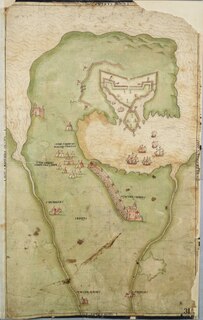
The Siege of Smerwick took place at Ard na Caithne in November 1580, during the Second Desmond Rebellion in Ireland. A force of between 400 and 700 Papal freelance soldiers, mostly of Spanish and Italian origin, landed at Smerwick to support the Catholic rebels. They were forced to retreat to the nearby promontory fort of Dún an Óir, where they were besieged by the English. The Papal commander parleyed and was bribed, and the defenders surrendered within a few days. The officers were spared, but the other ranks were then summarily executed on the orders of the English commander, Arthur Grey, the Lord Deputy of Ireland.

Commandos a.k.a. Sullivan's Marauders is a 1968 Italian-produced war film filmed on Sardinia starring Lee Van Cleef and Jack Kelly and directed by Armando Crispino.

A Man There Was is a 1917 Swedish drama directed by Victor Sjöström, based on a poem of the same title by Henrik Ibsen. With a budget of SEK 60,000, it was the most expensive Swedish film made up to that point, marking a new direction in Swedish cinema with more funding to fewer films, resulting in more total quality.

The Tightrope Men is a novel written by English author Desmond Bagley, and was first published in 1973.
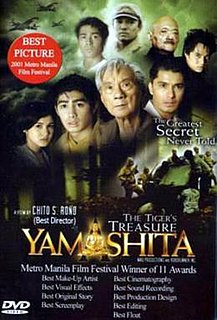
Yamashita: The Tiger's Treasure is a 2001 Filipino epic adventure-drama film directed by Chito S. Roño and starring Armando Goyena, Danilo Barrios, Albert Martinez, Vic Diaz, BB Gandanghari, and Camille Prats. Its plot concerns a hidden Yamashita treasure. It was released by Regal Entertainment. The film won a total of 11 awards in various award-giving bodies including the coveted Metro Manila Film Festival for Best Picture.

Snow Treasure is a children's novel by Marie McSwigan. Set in Nazi-occupied Norway during World War II, it recounts the story of several Norwegian children who use sleds to smuggle their country's gold bullion past German guards to a waiting ship, the Cleng Peerson. Published in 1942, it has been in print ever since. The book was made into a film of the same name in 1968, directed by Irving Jacoby.

Operation Fish was the World War II evacuation of British wealth from the UK to Canada. It was the biggest known movement of wealth in history.



















